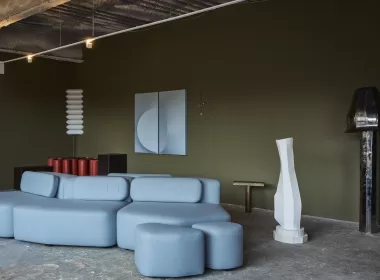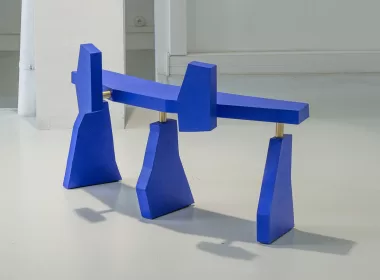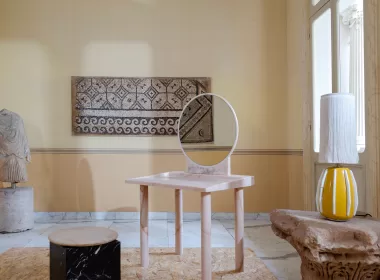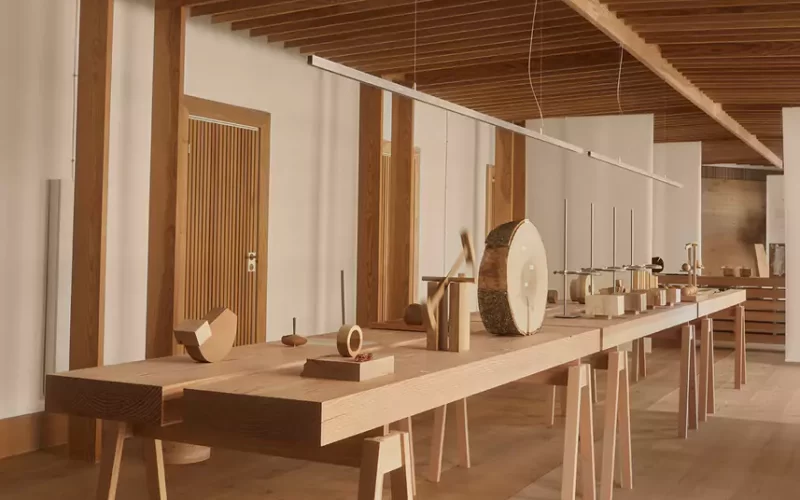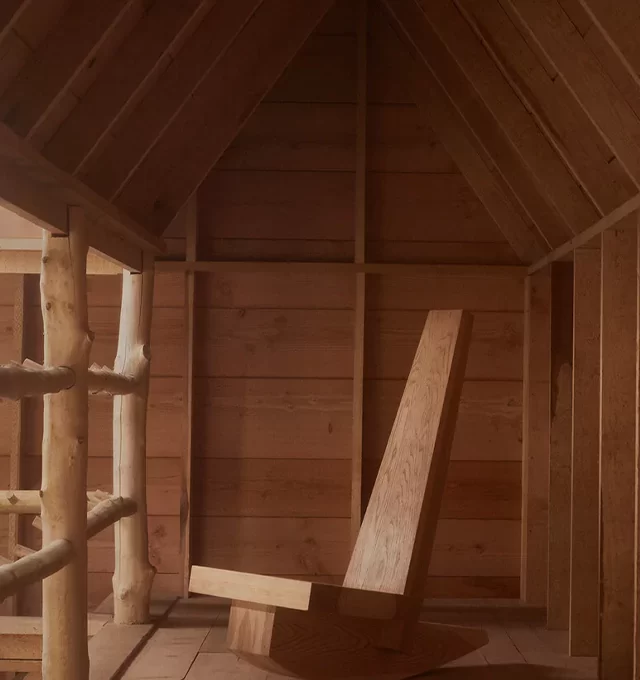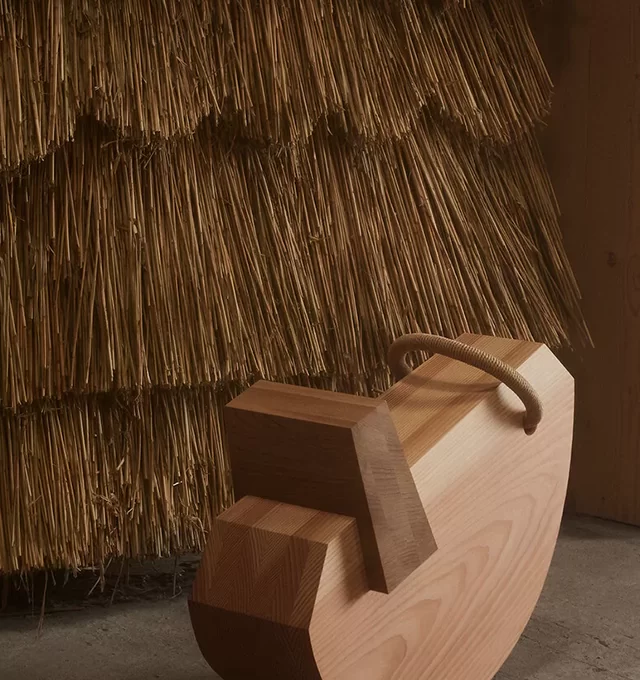During the 3daysdesign 2023 in Copenhagen, the designer duo Christian Hammer Juhl and Jade Chan, alias Christian+Jade, presented the results of the research Weight of Wood on the physical properties of wood through the collaboration with the Danish company Dinesen. The research took the form of an artist residency in a Jutland sawmill in southern Denmark and lasted about a year. In this period the two designers stopped to investigate the technical peculiarities of wood and above all what the relationship of the latter was with the environment and with the forest. This relationship is deciphered through the weight and density of the wood; and this would represent advantages in terms of design and could also be used as a useful tool for design. In addition to the purely technical aspect, the project with Dinesen offers food for thought both in anthropological terms in a historical period in which public opinion is directed towards living everyday life in a more ecological and sustainable way.
How did this research come about and why did you decide to invest a whole year in the study of wood?
C+J – Our research into wood actually stemmed from a very simple question that every designer or maker is confronted with when facing the material: which wood should I use? And why? Wood has played a vital role in human life. From the moment our ancestors descended from trees, wood allowed us to tame fire, giving us warmth and light. Wood has since been essential to the evolution of our bodies and societies, allowing us to build our first tools for hunting, house for shelter, wheels for farming and boats for transporting. Today, wood remains all around us – it is used in our walls and floors, our tables and chairs, as if we have never been further removed from the forest and its trees.
Wood is a material commodity, and the choices we make in what wood we surround ourselves with is often limited to its colour, its grain, and the aesthetic it can provide to a space. We find joy in being able to really understand the materials around us. As designers, we see this as an opportunity to bridge the gap between a material as a commodity versus as a resource. Wood is a perfect example of this, as it is a vital link between nature and our built environment, and its origin as living and breathing entity can have a bigger stage.
The weight of wood is a property that you are often confronted with when standing with two different pieces of wood, and we saw it as a opportunity and great starting point for diving further into the material. It addresses all sorts of factors, from the conditions that a tree grew under, to the production process and we knew we had the opportunity to really form a narrative with it. A year was just barely enough to scratch the surface of the vast, complex, world around wood and the forest. The material amazed us time and time again, and really sparked a curiosity and re-appreciation for its beauty, reminding us why indeed human beings have always chosen to surround itself with this material. Ultimately, we also hope to understand how the design and creation process can foster deeper connections between ourselves, the material itself and the natural world.
Nature cannot be imitated, and there is so much honesty and beauty in its imperfection
More people choose to surround themselves in natural environments, a greater respect, more empirical knowledge and a sense of responsibility for nature has the potential to completely shift the way we may choose to live and consume.
This is a period where the lifestyle of the city is being questioned and for this reason many people decide to move to rural areas. In the near future, what do you think the relationship between man and forest will be like and how do you think it will develop?
Leaving aside the historical and anthropological aspect, what do you think is the current relationship between man and wood and how will it develop in the future?
C+J – We hope that it is okay to combine these questions as we think that the relationship between man, wood and forest are intertwined. A good example of how we see the changing relationship between our understanding of wood is through people’s desire and preference in choosing floorboards. There used to be a greater desire for wooden floors that do not have knots or imperfection, and are as homogenous as possible. However, there is a growing understanding and appreciation for wooden floors that not only display a variety of knots but also cracks and irregularities. We believe that this is also a move away from the growing amount of materials that can mimic a “perfect” piece of wood. However, nature cannot be imitated, and there is so much honesty and beauty in its imperfection. We do feel a general slow change in people’s perception of what natural material looks and feels like, and a willingness to surrender the control we have tried to assert over materials.
We think this mentality is also reflected in a greater desire in people to live in or close to nature. Many cities have been built in ways in which we have grown more disconnected from the earth that we harvest from to support our lives. As more people choose to surround themselves in natural environments, a greater respect, more empirical knowledge and a sense of responsibility for nature has the potential to completely shift the way we may choose to live and consume. We believe things can change for the better, and we hope to be a part of it to our best abilities.
Why did you decide to divide your research into three parts and what would be the goal of each?
C+J – The answer to wood’s weight was not as simple as we had imagined. It opened up a broad, complex, world with many different factors, elements and exceptions. In attempt to condense the research, we chose to encapsulate them within tree crucial ways that we felt could imitate our understanding of wood. Wood as an part of a large ecosystem, wood as an individual, and wood in relation to our lives s human.
Wood and Forest
Forest and Wood is an introduction to the concept of wood density. This area offers a preliminary insight into how we can learn about the environment in which a tree grew by examining its growth rings and end grains. The forest determines the growth of a tree, providing nutrient-rich soils, sunlight and water supply. However, every forest is different, and the condition under which each tree grows can significantly transform the character of a tree – from the amount of light it receives to it’s neighbouring trees and plants. Every little change in its growth and journey can impact the weight of its wood. Learning to see the world in the grain of wood is a reminder that wood is not just a dead substance to be harvested and processed, but a living, breathing entity that is interconnected to the life of every other organism on the planet.
Wood and Wood
No two pieces of wood can weigh the same, even if they stem from the very same tree. Wood density has long been used to differentiate tree species and determine the type of wood for constructing a chair or building a boat. But what makes one type of wood denser than the other? Why is Ash heavier and stronger than Pine? Why is the heartwood of the Oak denser than its sapwood? Wood and Wood eliminates the factor of the forest, by focusing on trees that grow under similar conditions. The wood represented here are the main tree species growing in The Black Forest of Schwarzwald in Germany, where most of Dinesen’s wood is sourced. By diving into different factors that influence the weight of wood, from wood anatomy to growth strategy, we understand each species as unique individuals and the roles they play in our lives. On display is the intangible quality of weight translated into visual and interactive forms, allowing us to explore each wood’s characteristic and strength.
Wood and Human
Wood has played an intrinsic role in the history of human civilization, and our relationship is far from over. As we aim to move towards a more sustainable and responsible world, wood’s future has never been more intimately tied to our own. In Wood and Human, we end where we began, surrounded by wood, but a step closer to understanding the importance of the forest and its trees. The hidden life and stories behind a single plank of wood are no different from the stories of life itself, of nature and nurture, of birth, growth and renewal Weight of Wood is an ongoing journey to uncover the different faces of wood, weaving its stories together to challenge the way we see and understand this all too familiar material – not just as a means for construction or a beautiful surface, but as a natural living resource that is intrinsically rooted in the world that we all depend on and live in. Weight of Wood concludes with three furniture pieces, that bring the knowledge gained through the experiments and research back into our homes and lives: A Rocking Horse, a Seesaw and a Rocking Chair. The three furniture pieces have each played a role in the cycle of life. We have re-imagined the objects using wood’s varying qualities, resulting in a playful balance of weight and movement, crafted with Dinesen Oak, Ash, Douglas and Pine.
Learning to see the world in the grain of wood is a reminder that wood is not just a dead substance to be harvested and processed, but a living, breathing entity that is interconnected to the life of every other organism on the planet.
The formal result of your project is characterised by primitive forms, why did you decide not to formally exploit all the potential of wood?
C+J – The research and experiments we made all consist of simple, geometrical forms that attempt to make the intangible quality of wood something you can see, touch and feel. The success of it lies in its simplicity, that one is able to clearly understand the difference between each wood’s weight. For the furnitures, we took an active choice to focus on allowing the property of each wood within each furniture to shine. This meant having to keep the forms as simple as possible. There was also a nod to the playful language of building blocks and toys that we can all relate to.
After this research experience on what will be its use of wood in your projects in the future?
C+J – We definitely feel like this was only an introduction and us scratching the surface. Each and every expert we met on our journey has opened up different doors within the world of wood for us. From learning about tree migration and the species that will prevail in the changing climate, to discovering the level of interdependence within a forest ecosystem. We definitely see the possibility to continue developing this methodology and diving into just one species of wood, or perhaps investigating a different forest region. (We focused on the black forest of Schwarzwald for the exhibition.
Unlike all other materials, we can say that wood has its own energy from which a series of sensations and emotions arise. Could you describe us which ones are yours?
C+J – We think that this quote from Wooden Life by Emmanuel Coccia really encapsulates why we feel intrinsically drawn to wood, at home around its presence, and soothed by its warmth. “Our relationship with this material coincides with our own genesis as a human species. We are arboreal primates trees have given birth to our species. Our way of life comes from a very special environment: the forest. Life in trees has imposed our form on us. The opposable thumb that distinguishes us from the rest of the biologically closest species is a result of our close combat with trees-it is the solution that has allowed us to movee better between their branches. The two eyes, close together on the forehead are also their work; it is in this way that depth in the visual field becomes visible. Our anatomical identity stems from our relationship with trees and therefore with wood: relating to our body means relating to the trees and the wood that shaped it. Like a reversal of the history of Pinocchio, it is not the carpenter who has carved a puppet from pine wood; it is the wood that has carved our body, piece by piece. Wood made us human. That’s why we need to surround ourselves with wooden objects and surfaces in order to feel human.


